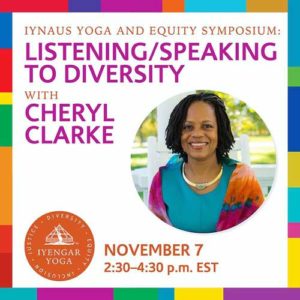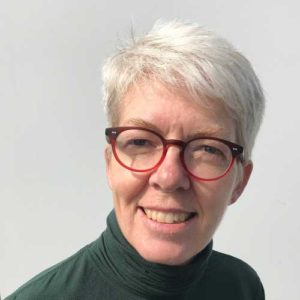Listening/Speaking to Diversity
by Christine Rondeau
The turmoil and upheaval of these past few months have brought most of us to examine and question our stance when it comes to racism, able-ism, ageism and all the other isms that creep into our lives without us realizing it. Whether it’s through the Black Lives Matter protests, climate change movements, Indigenous land claims, we’ve all been made more aware that injustice is real and, for many, a daily struggle. The Iyengar Associations of Canada (IYAC/ACYI) and the US (IYNAUS) and our local Vancouver Association all recognize that yoga has a role to play.
 On November 7th, IYNAUS presented its first online Yoga and Equity Symposium workshop entitled “Listening/Speaking to Diversity”. Led by diversity and inclusion consultant Cheryl Clarke, the workshop looked at ways to establish Diversity, Equity, Inclusion and Justice (DEIJ) in relation to our Iyengar yoga community. Myself, along with 115 other participants learned about foundational principles, common language, and greater sensitivity in how we can communicate. We examined the role that yoga plays when it comes to DEIJ.
On November 7th, IYNAUS presented its first online Yoga and Equity Symposium workshop entitled “Listening/Speaking to Diversity”. Led by diversity and inclusion consultant Cheryl Clarke, the workshop looked at ways to establish Diversity, Equity, Inclusion and Justice (DEIJ) in relation to our Iyengar yoga community. Myself, along with 115 other participants learned about foundational principles, common language, and greater sensitivity in how we can communicate. We examined the role that yoga plays when it comes to DEIJ.
We all know that yoga is healing. Yoga is beneficial to our nervous system, our alignment, our joints but it can also bring relief from injustice and peace to our soul. During teacher training, we’ve been told to “teach to what you see”. Lift the inner leg, bring the buttocks in, ground the big toe… these are the first actions we learn to see and teach. Once a teacher has had time and practice to recognize these gross actions, then the more subtle ones are noticed. Your hamstrings are tight, use a chair. You have scoliosis? Here’s a more suitable pose that will heal your spine instead of aggravating it. The “teach to what you see” principle has made Iyengar Yoga inclusive and welcomes practitioners with stiffer bodies and illnesses to participate, but that’s not enough.
As a yoga practitioner and yoga teacher it’s important to understand how our actions, behaviours and words can affect others. We have to be aware of our unconscious biases. Do we turn away from certain people based on their gender, the colour of their skin, their body type? Do we avoid eye contact with them? Cheryl reminded us that everyone comes to their mat with different burdens, different needs and different wishes. As fellow yogis and as teachers we must respect that. A small look, or no look, can trigger trauma. We need to be aware of our own opinions and ask ourselves where do they come from? We need to make sure that all barriers are removed so that everyone feels welcome.
“There is no difference in souls, only the ideas about ourselves that we wear.” B.K.S. Iyengar
Cheryl emphasized that racism, stereotypes, prejudices and all forms of discrimation are a result of years and years of systemic oppression developed by governments, institutions, the media and people of power. Eliminating these will take time and effort, and will require tremendous work.
During the workshop, we had the opportunity to break out into smaller groups and examine the following challenges faced by the Iyengar Yoga community:
- Current imagery of yoga doesn’t reflect diversity
- Yoga is seen as a privilege for the upper class
- Yoga can be expensive
- Yoga classes are not accessible or convenient to all neighbourhoods
- Lack of diversity in our teachers
- The cost (time and money) of teacher training
- Yoga studios are not safe places for all people
These discussions allowed us to come together, to discuss, listen, share, and contemplate. We scratched the surface to see what lies beneath.
This two hour workshop didn’t conclude with any big takeaways, but started the healing process and self study required to address these issues. I look forward to the next workshop, to see where it leads and how yoga studios can be made more welcoming to marginalized communities and people of colour.

